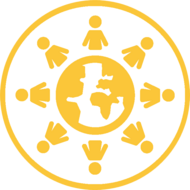
(View Complete Item Description)
The Change & Impact module, from the Supporting Readiness through Vital Civic Empowerment (SRVCE) curriculum, focuses on the role young people can play in making a difference in their own communities. Students hone civic engagement skills as they develop a plan of action for a community-based challenge they care about.
The 15 lessons include video, student-facing slides, a teacher toolkit and handouts. Resources are aligned with the C3 Framework for Social Studies State Standards, National Association for Media Literacy Education (NAMLE) Core Principles of Media Literacy Education, and Collaborative for Academic, Social, and Emotional Learning (CASEL) Social and Emotional Learning Competencies.
SRVCE blends inquiry-based civic learning, media literacy education, and exploration of public service careers to prepare students to be active citizens and thrive in the workforce. All SRVCE materials are free. These materials are intended solely for educational purposes. Educators may modify the materials to suit the specific needs of their students. This may include adapting the materials for various settings and purposes, provided that such changes are made within the scope of the specific educational use.
.
Material Type:
Lesson,
Lesson Plan,
Module,
Teaching/Learning Strategy,
Unit of Study
Author:
Education Development Center




















